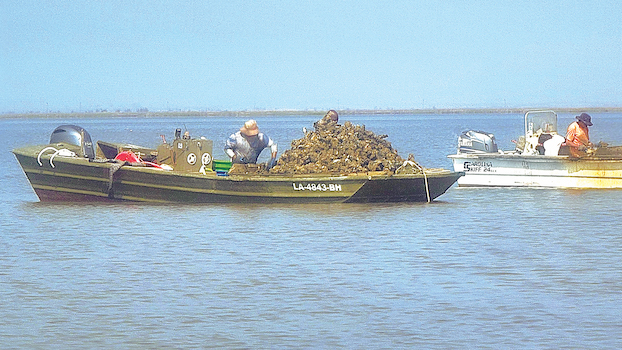Alternative Oyster Culture: Saltwater bivalve mollusks will soon be growing in floating cages attached to pylons in Calcasieu Lake
Published 1:56 am Wednesday, May 3, 2023

- Oystermen harvested oysters by dredging up until around 2017. Now they are limited to using tongs. This shows a day’s harvest from Anthony Theriot. (Special to the American Press)
The Cameron Parish Port, Harbor and Terminal District has been selected for an Alternative Oyster Culture (AOC) grant to establish a 48-acre oyster park at the southern end of the Calcasieu Lake/Big Lake. Cameron Parish oystermen Anthony Theriot and Hubern Doxey, and other grant recipients, hope this new way of growing oysters will make them more market competitive, particularly in the half-shell market.
Alternative Oyster Culture (AOC) is the growing of oysters in floating cages attached to pylons. Cages can be raised and lowered to protect oysters from predators, fouling and certain weather disaster effects, according to Kim Montie, Executive Director, Cameron Parish Port, Harbor and Terminal District.
The oyster season closed here on Sunday, April 30. Anthony Theriot was up on that final morning and on the water at 7 a.m. to get his limit, 15 bags, for which he received $53 a sack from a local shop.
He’ll spend the next months shrimping for a market inundated with imported shrimp.
“Last year, the price for shrimp just went to nothing, 50 cents a pound,” Theriot said. “It costs you $350 to catch $500 worth of shrimp. That’s coast wide, not just here.”
Theriot and Doxey see AOC farming as a means to get more for their labors. AOC could allow for the production of smaller-sized (around three-inch), more rounded and uniform filled-out oysters, not “lizard tongues,” as Doxey put it. That’s what restaurants and individuals are after for serving oysters on the half shell. These alternatively grown oysters could be sold individually, yielding more for the oystermen than the sack price. It could also allow the oyster farmer to cut out the middleman in some transactions, according to Theriot.
Theriot said a sack of oysters produce about 6.4 pounds of meat. It’s packaged at one of the shops in Cameron Parish and purchased by a seafood distributor. Chesapeake Bay oysters, which have had similar ups and downs as the Gulf Coast oyster market, are meatier, according to Theriot.
A second advantage of AOC is that oystermen will not be limited to the harvesting season to sell oysters. Most of the oyster seeds will be triploid oysters, and will grow faster as the nutrient intake goes to oyster growth and not reproductive energy, Montie said. Plus, the cages are positioned near the algae the oysters feed on.
AOC is labor intensive, but maybe not as labor intensive as tonging. Doxey, a third generation oysterman, said he gets in the water in a wetsuit and uses his feet a lot of the time to dislodge the oysters, then throws them into a shrimp basket supported by a life ring. He’s seen a lot of spat this year.
“That’s a good sign,” he said.
When oyster larvae attach to a surface, it’s known as spat. As generations of spat grow into adult oysters, these form dense clusters known as oyster reefs or beds.
Louisiana Department of Wildlife and Fisheries and biologists with Sea Grant chose the Cameron Parish location based on salinity, tidal flow and the fact that oysters were living on natural reefs in that location, but were not in abundance, according to Montie. She said the water bottoms are owned by the State of Louisiana Land Office. The Cameron Port, Harbor and Terminal District will be the administrator of the AOC Park.
The Park set-up grant was awarded by Wildlife and Fishers and Louisiana Coastal Protection Restoration Authority (CPRA) and managed by Sea Grant with financing from the Iberia Development Foundation.
Kevin Savoie, Sea Grant and LSU AgFisheries Extension said the oyster industry in Cameron Parish has been through its share of ups and downs. Dredging was used as long as there was a good crop, which was usually the case, until severe weather events began to dump fresh water into Big Lake and threaten the brackish balance essential for oyster growth.
Dredging, in addition to being easier than using tongs – and feet – had the advantage of removing hooked mussels as the dredging tumbled oysters against each other. The mussels compete with oysters for food and space, which doesn’t allow them to fill out.
The Grand Isle Louisiana Sea Grant Oyster Hatchery developed the model for AOC over ten years ago and was operating as a demonstration site until recent hurricanes.
“The biggest risk to AOC success for oystermen in Cameron Parish is extreme weather,” Savoie said. “These grants help mitigate some of the financial risks such as start up costs.”
Grants were awarded throughout the Louisiana coastal region so that a weather disaster could not knock out the state’s entire oyster industry with one event.
Work will begin on the Park this summer, Savoie said. Next fall, cages will be in the water. By 2024, it might be possible to walk into a Cameron or Calcasieu Parish restaurant and order a dozen oysters on the half shell, delivered minutes before by Doxey, Theriot or other AOC oystermen.





